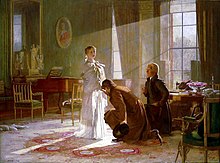Francis Conyngham, 2nd Marquess Conyngham
Victoria | |
|---|---|
| Prime Minister | The Viscount Melbourne |
| Preceded by | The Marquess Wellesley |
| Succeeded by | The Earl of Uxbridge |
| Personal details | |
| Born | Francis Nathaniel Conyngham 11 June 1797 Dublin, Ireland |
| Died | 17 July 1876 (aged 79) London, England |
| Nationality | British |
| Spouse(s) | Lady Jane Paget (1804–1876) |
Francis Nathaniel Conyngham, 2nd Marquess Conyngham,
Background and education
Born in
Political career
Conyngham was returned to Parliament for
In July 1834 Lord Conyngham joined the
Lord Conyngham was also Vice-Admiral of Ulster between 1849 and 1876 and Lord-Lieutenant of County Meath between 1869 and 1876. He was made a Knight Grand Cross of the Hanoverian Order in 1830[1] and a Knight of the Order of St Patrick in 1833.[5]
Military career
On 21 September 1820, Conyngham purchased a cornetcy in the
Ireland and the Hunger
Burton-Conyngham was an absentee landlord in control of some territories in Ireland; particularly in County Donegal (covering Glenties, Arranmore and most of the barony of Boylagh) in Ulster.[14] He showed little interest in these estates he claimed there. According to Thomas Campbell Foster in an 1845 report for The Times of London newspaper, entitled "Commissioner to report on the condition of the people of Ireland", he had visited the area once in his life for a few days.[14] Burton-Conyngham instead hired John Benbow, an English MP, as his chief managing agent, who visited once a year and sub-agents collected rent from tenants each half a year. Foster's report described these estates as such "from one end of his large estate here to the other, nothing is to be found but poverty, misery, wretched cultivation, and infinite subdivision of land."[14]
As the poverty was particularly severe on Burton-Conyngham's estates, the
Courtier

In his youth, Lord Conyngham was a
Family
Lord Conyngham married Lady Jane Paget, daughter of Henry Paget, 1st Marquess of Anglesey, on 23 April 1824. They had six children:
- George Henry Conyngham, 3rd Marquess Conyngham (1825–1882)
- Lady Jane Conyngham (1826–1900), married Francis Spencer, 2nd Baron Churchill and had issue.
- Lady Frances Caroline Martha Conyngham (1827–1898), married Gustavus Lambart and had issue.
- Lady Elizabeth Georgiana Conyngham (1829-1904), married George Finch-Hatton, 11th Earl of Winchilsea.
- Lady Cecilia Augusta Conyngham (1831-1877), married Sir Theodore Brinckman, 2nd Baronet and had issue.
- Lord Francis Nathaniel Conyngham (1832–1880), politician.
Lady Conyngham died at Folkestone, Kent, in January 1876, aged 77. Lord Conyngham only survived her by five months and died in London in July 1876, aged 79, after an operation for lithotomy. He was succeeded in the marquessate by his eldest son, George.[1]
References
- ^ a b c d e f g h i j thepeerage.com General Sir Francis Nathaniel Conyngham, 2nd Marquess Conyngham
- ^ "leighrayment.com House of Commons: Waterloo to West Looe". Archived from the original on 1 May 2009. Retrieved 24 August 2009.
{{cite web}}: CS1 maint: unfit URL (link) - ^ "leighrayment.com House of Commons: Devizes to Dorset West". Archived from the original on 11 October 2017. Retrieved 24 August 2009.
{{cite web}}: CS1 maint: unfit URL (link) - ^ "No. 19272". The London Gazette. 22 May 1835. p. 980.
- ^ "No. 19034". The London Gazette. 29 March 1833. p. 617.
- ^ "No. 17638". The London Gazette. 30 September 1820. p. 1848.
- ^ "No. 17697". The London Gazette. 14 April 1821. p. 838.
- ^ "No. 17708". The London Gazette. 19 May 1821. p. 1082.
- ^ "No. 17769". The London Gazette. 1 December 1821. p. 2343.
- ^ "No. 17778". The London Gazette. 1 January 1822. p. 1.
- ^ "No. 17915". The London Gazette. 19 April 1823. p. 626.
- ^ "No. 17935". The London Gazette. 28 June 1823. p. 1050.
- ^ "No. 18401". The London Gazette. 2 October 1827. p. 2033.
- ^ a b c d "The Famine--"The Times"--and Donegal: Part III". Vindicator. 5 December 2015.
- ^ a b "Famine Times in Donegal". Irish Famine Pots. 5 December 2015.
- ^ "Beaver Island and Arranmore Island". We Love Donegal. 5 December 2015. Archived from the original on 4 July 2017. Retrieved 10 December 2016.
- ISBN 1-85619-086-2, pp. 55–57
- ISBN 0-241-02200-2, p. 138
